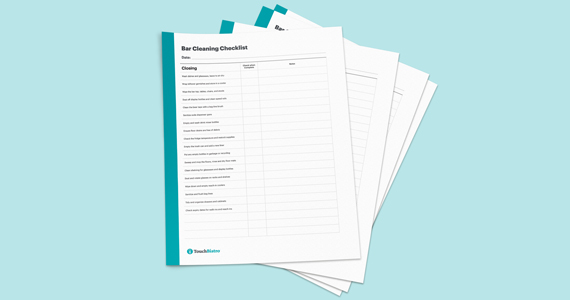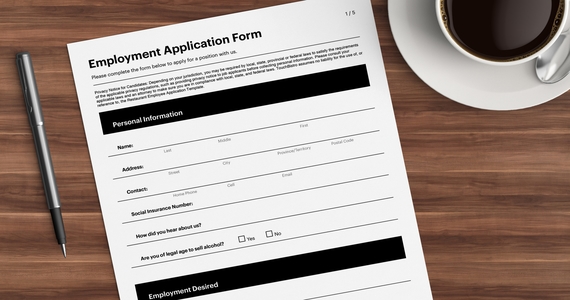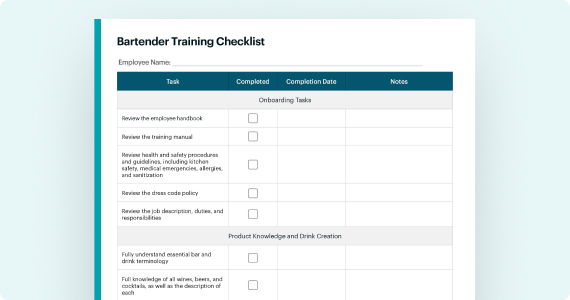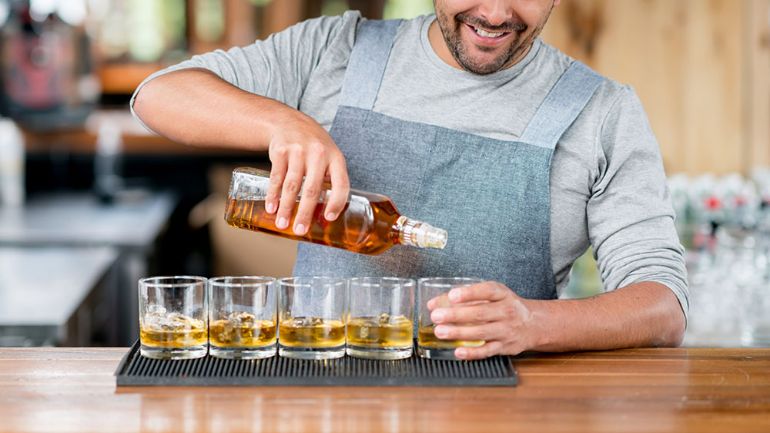It’s Friday night and your bar is packed. Bartenders are struggling to keep up with drink orders and customers are starting to notice the delay. Who could come to the rescue? A barback, that’s who.
But wait – what is a barback?
Though they’re often confused with bartenders, barbacks are a separate role that focus on assisting bartenders with bar-related tasks. They serve a unique and often critical role within restaurants and bars. That’s why it’s important to hire the right person for the job, starting with the right barback job description.
In this post, we’ll explore:
- What is a barback
- How to write the perfect barback job description
- How to hire, schedule, and train a barback
- How to know when a barback is ready to be your next bartender
What is a Barback and Do I Need to Hire One?
A barback is an assistant to your bartenders during especially busy times at your bar or restaurant. They help prevent front-of-house staff from getting stuck “in the weeds.”
Barbacks are helpful when bartenders can’t keep an eye on certain things, such as refilling bottles and garnishes and cleaning up the bar area.
But barbacks aren’t limited to a few duties. They do anything and everything that needs to be done in the bar and the restaurant. Every venue has different barback duties and responsibilities based on the experience they want to create for their customers, but a few core tasks remain consistent:
- Refilling bottles at the bar
- Preparing and replenishing garnishes
- Collecting and washing empty glassware
- Cleaning up messes
When barbacks relieve bartenders of these chores, bartenders can focus on crafting the best whisky sours and margaritas instead of running downstairs for a desperately needed bottle of vodka.

Use this customizable bar cleaning checklist to keep your restaurant bar looking spotless.
Most barbacks are expected to go above and beyond their job description. Many barbacks work roles that are understaffed that day or chat with customers like a bartender would. They might even work the deep fryers and get food from the kitchen counter to the customer’s table.
The one thing they don’t do? Serve drinks.
Overall, the barback role is demanding. They’re on their feet all day moving around the restaurant. They can be seen lifting heavy beer kegs and moving cases of liquor bottles up and down the stairs.
Barbacks are commonly paid tipped minimum wage and receive a tip out directly from bartenders (usually 1–2% of sales or 5–20% of tips). If it’s a busy night with multiple bartenders behind the bar, a barback could rake in over a couple hundred dollars in a single shift.

Streamline the hiring process with our printable restaurant job application template.
How to Craft the Perfect Barback Job Description
Barback duties and responsibilities have to match the needs of your business. And since every bar is different, every barback job description will be, too.
A good bar manager should know what their restaurant/bar needs and use this to craft the job description. If you expect your barback to also work the deep fryers, it’s good to note this in the job description.
Of course, you can’t predict everything. Do your best to list what they can expect, but let any new barbacks know that they’ll likely have to prepare for some odd jobs.
A great barback job description lists the qualities of a perfect barback. Here is a list of hard and soft skills the perfect barback should have.
Hard skills for barbacks:
- Ability to lift heavy objects: Since barbacks carry kegs and loaded boxes, they’ll likely need to be able to carry at least 40 pounds.
- Basic knife skills: They’ll need to prepare garnishes for the bar and possibly some prep work for the kitchen.
- Basic bar knowledge: While there are lots of opportunities for on-the-job learning, your new barback should at least have a basic knowledge of different spirits, wines, and beers.

Use this customizable bar cleaning checklist to keep your restaurant bar looking spotless.
Soft skills for barbacks:
- Prioritization: In a restaurant or bar, dozens of issues may come up all at once. A barback needs to know what to do first.
- Multitasking: Efficiency is key during dinner or lunch service. Small things like answering a customer’s question while cleaning dirty glasses can help a barback save time they’ll need later on.
- Taking initiative: A good barback refills bottles before the bartender even notices that they’re empty.
- Working under pressure: A barback has to move fast to keep up with the flow of the restaurant or bar, especially at peak times.
- Problem solving: Working in a bar sometimes means working with difficult customers. The ideal employee is someone who can deal with these situations calmly and professionally.
- Customer service: Part of the job requires talking to customers, so make sure to hire someone who is friendly and helpful.
- Quick learning: Things move quickly at restaurants, so barbacks need to pick up the skills and responsibilities at a fast pace to really help the business run smoothly.
Besides the paycheck, people are often eager to become barbacks because they’re interested in eventually becoming a bartender. A good barback job description should entice candidates with opportunities to learn how to work in a bar and, one day, become a bartender (if this is possible).
How to Get Your Barback Job Description Noticed

Hiring a barback is like staffing any other role at a restaurant or bar. Online job sites, referrals, and “now hiring” signs are all good ways to find the next member of your restaurant family.
When you start the search, make sure your employees – especially your bartenders and other all-star staff – know. They could have friends looking for a barback role. Add a referral bonus into the mix and your current employees just might dig into their Facebook friend lists.
Then there’s always online job boards. Places like indeed.com or monster.com have thousands, if not millions, of postings every day and even more people applying to them. And more niche job boards like restojobs.ca narrow the search down to applicants looking for restaurant jobs. This can help weed out some of the people who have never stepped beyond the customer side of a restaurant.
Walk-in applicants who see a “now hiring” sign should be welcomed, too. Add an email address or website for applications to prevent people from walking in with resumes and disrupting your business.
Note: Beware of anyone who walks in with a resume during your Friday night rush. Someone who understands the restaurant business (i.e. the person you want to hire) will avoid dropping by at these times.

Use this checklist to help streamline the training process for new bar staff and set them up for success.
Interviewing Barback Candidates
Once you choose the resumes you like – and throw out the ones you don’t – it’s time to interview them.
Find someone you enjoy speaking to and figure out what their goals are – are they looking for a temporary job or do they want to stay for the long term and become a bartender?
An interview helps you see if the person has the soft skills needed for the role and for your bar or restaurant.
Here are a few interview questions to consider:
- Where do you see yourself in the next year? Two years? Five years?
- How do you deal with a stressful environment?
- Tell me about a situation where you needed to multitask.
- How would you deal with a difficult customer in the bar?
Training Your Barback
Training a barback is like training any other employee. Clearly communicate the rules and procedures, so they have the best chance of succeeding (preventing you from having to rehire).
Be especially clear about things like dress code, acceptable behavior, and level of service staff are expected to give customers – ideally as part of an employee manual. This can prevent highlighter yellow shoes and over-friendliness (like, the creepy kind).
Even if your newbie has previous bar experience, you should teach them the basics of your bar.
To ease a new barback into the role, provide a checklist for:
- All the alcohol and garnishes they need to replenish
- Side duties for slower hours
- Opening and closing duties for the bar
It’s also important to familiarize new barbacks with your drink menu, daily specials, and any other unique elements that will affect their daily duties.
Also, make sure to teach them how to treat the regulars – how Fred, who comes in every Monday after work, always likes watching the Golf Channel on the corner TV.
If you plan to promote barbacks to bartenders, consider setting up an apprentice program. This type of mentorship provides the barback with a clear mandate on how they can move into the bartending role and helps bartenders know what, when, and how they should teach certain skills.

Download this customizable restaurant training manual template to ensure a smoother onboarding and training process for staff.
When to Schedule Your Barback
Good staff scheduling is key to a bar or restaurant’s success. There are times when your bar will need a handful of barbacks and other times when you won’t need any.
During the slower moments, a bar can manage with a single bartender to take care of customers while also replenishing garnishes and alcohol. Unoccupied bussers and hosts can also take on barback duties.
But on busier nights, when every bartender is trying to make a dozen gin and tonics at once, you’ll need more than one barback refilling lemons slices.
It’s important to have a system for communicating start and (approximate) end times for your barback (beyond “start when the sun sets and end when the sun rises”).
Scheduling software can help with this process, letting barbacks look at their schedule through an app and swap shifts on the fly.
How to Know When Your Barback is Ready to Bartend

There’s no exact timeframe for a barback to transition into a bartender role, but many restaurants find the sweet spot is 12–16 months – enough time to learn the ins and outs of a bar and to realize it’s not as glamorous as it seems on TV.
There are also some bars that serve more complex drinks or even a niche menu and need bartenders to have a higher skill set. For these places, a barback will likely need more than 16 months before they’re ready to bartend, even if they’re a superstar.
When it’s time to pop the champagne and put your barback on their first bartending shift, there’s usually a transition period. The barback may bartend during slower shifts or work as a backup for a more experienced, lead bartender.
But before putting your barback on any bartending shift, make sure that they can legally serve alcohol. In the U.S., the age to serve alcohol is between 18–21, depending on the state. And in Canada, most provinces and territories allow anyone 18 or over to serve alcohol, as long as they have a license to do so. One exception is British Columbia, which requires bartenders to be at least 19.
Your former barback may also need certain certifications to serve alcohol. This ultimately depends on the province, state, or city that you’re serving in. It’s important to check with local government to make sure your staff have the right certifications for their roles.
A barback is an important role in many restaurants and bars. If you’ve seen your bartenders scrambling for garnishes or cleaning up spills when they could be making drinks, it may be time to put out a job posting for your next barback.
Download your free employee handbook template
Sign up for our free weekly TouchBistro Newsletter







